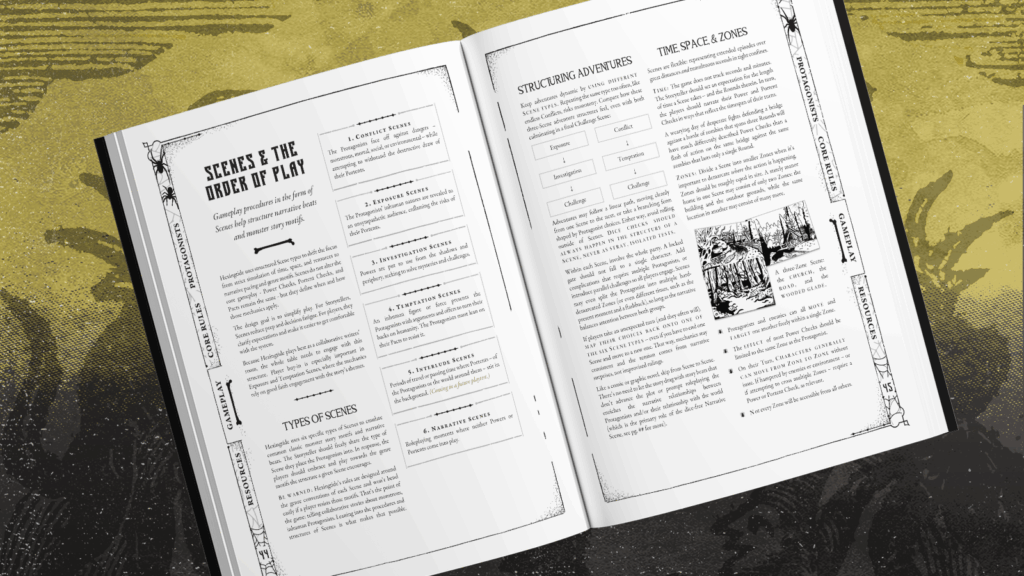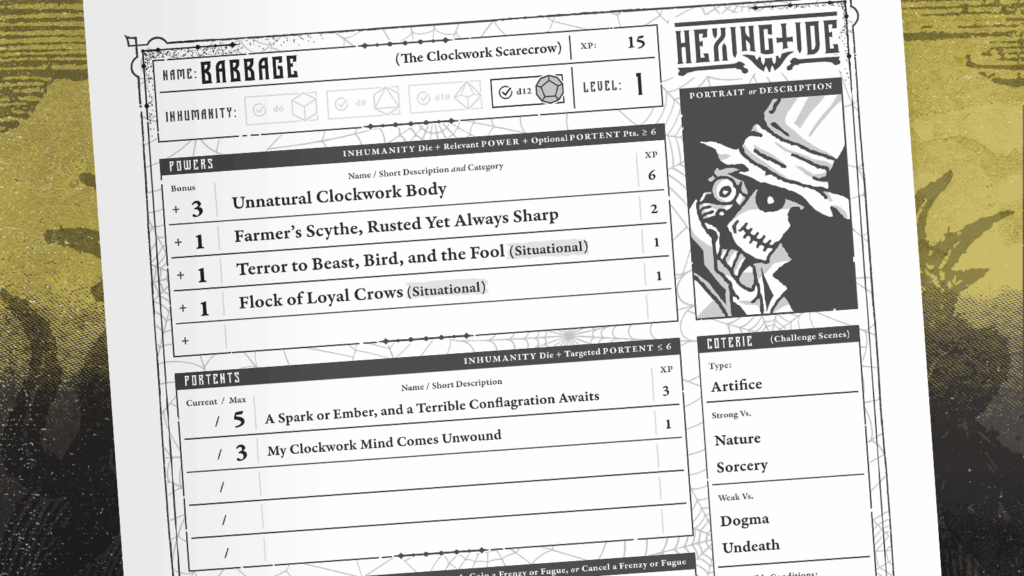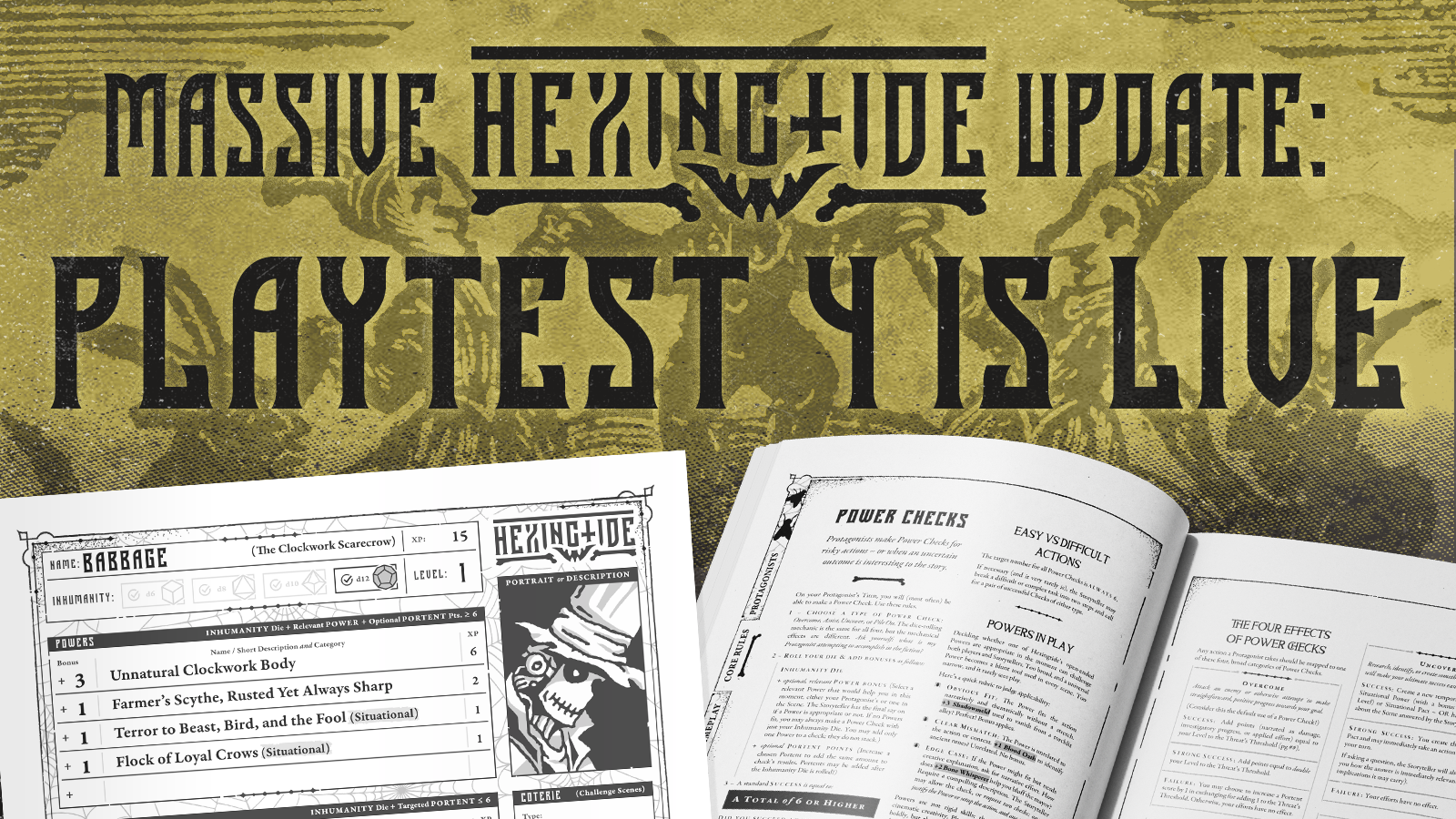It’s finally here! I’m thrilled to announce that Hexingtide Playtest 4 is now available. It has been a long road since Playtest 3 dropped, and I’ll admit to battling major design block and burnout along the way. However, thanks to rigorous, bi-monthly sessions with my dedicated home group (thanks, gang), the game is in the most polished and rewarding state it has ever been.
Updates this year have been incremental, released as sections were completed. It wasn’t ideal, but sharing progress felt better than months of silence.
If you want to help shape what’s next, share your thoughts via the feedback form (hxti.de/feedback) or join the Hexingtide Discord server (hxti.de/discord). I’ll admit I’m not always at home on Discord – Elder Millennial energy – but I recognize that any future community depends on it.
What Documents are Included in Hexingtide Playtest 4
Everything you need to run the game in 8.5×11 inch US-sized PDF format:
- Hexingtide_0.4.6.pdf – The rules, themselves
- Hexingtide_0.4.6_Reference.pdf – Single page “cheat sheet” rules reference
- Hexingtide_0.4.6_Reference_XP_Costs.pdf – Single page summary of XP costs, helpful for building your Hexingtide Protagonist
- Hexingtide_CharacterSheet_0.4.6.pdf – As it says on the tin; second page is optional
- Hexingtide_0.4.6_Pregen_Babbage_Lvl1.pdf – the first of five pregen Protagonists
Download Hexingtide Playtest 4 on its Itch.io page:
https://willphillips.itch.io/hexingtide
1. What’s the Same in Playtest 4

- The Powers, Portents, and Pacts structure remains the bedrock of character creation – the tri-part system just works. I did make a subtle, but important, adjustment to XP costs. They were previously too low, which meant players at Levels 3 and 4 weren’t forced to make hard, thematic choices about how to spend on their abilities. The increased cost makes progression more meaningful.
- The Inhumanity die, the Strong and Weak mechanics, and the dual structure of Power Checks and Portent Checks remain intact. Roll 6 or higher for Power success and 6 or lower for Portent success. Strengths help your Power Checks; weaknesses complicate Portent Checks. This two sided relationship between your chosen Inhumanity die and the world remains at the heart of the system’s tragic, monstrous tensions.
- The open-ended, “aspect” or “tag” based design is also non-negotiable. This approach is essential for supporting the broad, creative character concepts that Hexingtide encourages.
2. What’s New or Changed in Playtest 4

- The most significant change is the growth in content and advice. Hexingtide is a brand-new set of rules – not a hack, not built on a familiar game’s SRD. Feedback made it clear that GMs needed more direction on design intent. The rules have evolved from an insufficient 12-page zine to 72 pages of guidance. Don’t worry, the spirit of “minimalist monstrous roleplaying” remains, but I now have comprehensive advice, design intent, and examples to make GMing a breeze.
- The most important structural change is the introduction of structured gameplay procedures in the form of six specific types of “Scenes.” This gives GMs and new players instant rhythm, allowing everyone to immediately lean into the genre themes. These Scene types – Challenge, Exposure, Investigation, Temptation, Interlude, and Narrative – move beyond the overly-simplistic Power/Portent Check cycle of earlier versions to offer specific mechanical contexts that give GMs the tools to shape vignettes common to monster stories.
- Chymoi have evolved – and been simplified – into Coteries. In previous playtests, the system of Chymoi based on the traditional Galenic humours – Blood, Bile, Phlegm, Black Bile, and Rot – was a piece of implied worldbuilding and the source of Strength & Weakness. In playtesting, it proved to be too nebulous and confusing. Coteries are a more straight-forward set of categories of monstrous archetypes: Artifice, Dogma, Nature, Sorcery, and Undeath. It’s been a huge improvement in play.
- I’ve also evolved the concept of Strength and Weakness with the introduction of Snares and Shadows that tie into Exposure and Investigation Scenes. Snares express the reactions of mundane humanity you are weak to, including Terror, Insanity, Obsession, Disgust, and Mockery. Shadows reflect the darker corners of humanity where you hold strength: the Alien, the Carnal, the Grotesque, the Ruinous, and the Taboo. This ensures mechanical tension in every interaction between the monstrous and the mundane.
- Impulses are the new method by which Protagonists earn XP. Impulses directly tie character advancement to the central conflict of the game: players create two Monstrous and one Human Impulse (or vice-versa) that serve as explicit roleplaying guides for earning experience, replacing simpler attendance-based rewards. This means Protagonists are only rewarded when they actively struggle between their inhuman nature and their mortal ties, making growth fundamentally rooted in fiction and dramatic choice.
4. What’s Next for Hexingtide

- My goal is to bring attention back to the game with an eye on playtest feedback (hxti.de/feedback). The game is in its best state – more playable, easier to GM, and mathematically sounder – but I need to verify that and to build a community around it.
- The immediate next development steps include finishing the remaining pregen characters (in addition to Babbage the clockwork scarecrow) and writing a starter or demo adventure. I don’t claim to be a strong adventure writer, so while this will be a learning experience, it’s necessary to show GMs how to stitch the new Scene mechanics together.
- My long term goal is to pursue publishing or crowdfunding for 2026’s Halloween season. The current 0.4.6 rules are fully playable, but the final single volume will include a complete Resources chapter (currently stubbed-out) with pregen characters, starter adventure, enemies, and random result spark tables – all of which will help support new GMs.
4. How You Can Help
- Review the rules and share your thoughts through the feedback form and/or Discord server.
- Consider running the game for others or sharing it with your TTRPG-playing friends. Visibility is the major hurdle for new, standalone indie games.
- I’d love to see a larger ecosystem for Hexingtide composed of additional adventures, drop-in-and-play Scenes, individual threats and monsters, and pregen character ideas. If you’re a TTRPG designer/writer and that’s of interest, I’d love to chat.
- Lastly, if you create content online and want to highlight indie rules light monster systems, I would be excited to collaborate.
In Closing
Thank you for your interest and patience. I hope Hexingtide’s Playtest 4 helps you tell the monster stories you want to play.
My goal is for gamers to recognize Hexingtide as a viable rules-light alternative to the World/Chronicles of Darkness lines, Curseborne, and those monster motif games built on 5E, PbtA, and FitD SRDs.
With your help and feedback, I think that can happen!
Download Hexingtide Playtest 4 on its Itch.io page:
https://willphillips.itch.io/hexingtide

